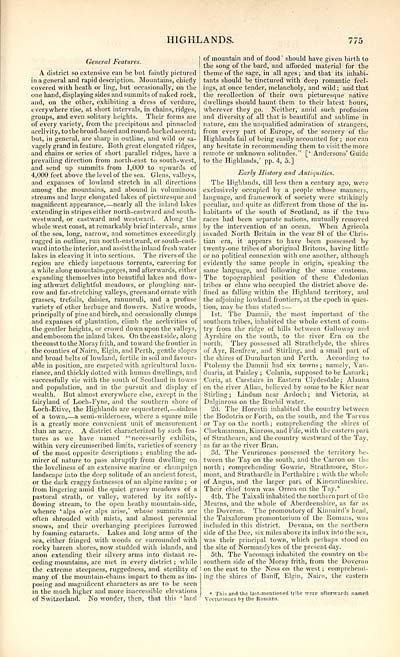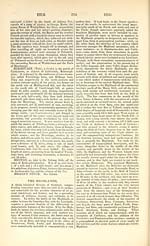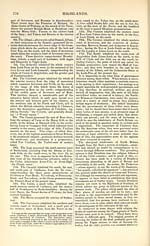Topographical, statistical, and historical gazetteer of Scotland > Volume 1
(875) Page 775
Download files
Complete book:
Individual page:
Thumbnail gallery: Grid view | List view

HIGHLANDS.
775
General Features.
A district so extensive can be but faintly pictured
in a general and rapid description. Mountains, chiefly
covered with heath or ling, but occasionally, on the
one hand, displaying sides and summits of naked rock,
and, on the other, exhibiting a dress of verdure,
everywhere rise, at short intervals, in chains, ridges,
groups, and even solitary heights. Their forms are
of every variety, from the precipitous and pinnacled
acclivity, to the broad-based and round-backed ascent;
but, in general, are sharp in outline, and wild or sa-
vagely grand in feature. Both great elongated ridges,
and chains or series of short parallel ridges, have a
prevailing direction from north-east to south-west,
and send up summits from 1,000 to upwards of
4,000 feet above the level of the sea. Glens, valleys,
and expanses of lowland stretch in all directions
among the mountains, and abound in voluminous
streams and large elongated lakes of picturesque and
magnificent appearance, — nearly all the inland lakes
extending in stripes either north-eastward and south-
westward, or eastward and .westward. Along the
whole west coast, at remarkably brief intervals, arms
of the sea, long, narrow, and sometimes exceedingly
rugged in outline, run north-eastward, or south-east-
ward into the interior, and assist the inland fresh water
lakes in cleaving it into sections. The rivers of the
region are chiefly impetuous torrents, careering for
a while along mountain-gorges, and afterwards, either
expanding themselves into beautiful lakes and flow-
ing athwart delightful meadows, or ploughing nar-
row and far-stretching valleys, green and ornate with
grasses, trefoils, daisies, ranunculi, and a profuse
variety of other herbage and flowers. Native woods,
principally of pine and birch, and occasionally clumps
and expanses of plantation, climb the acclivities of
the gentler heights, or crowd down upon the valleys,
and embosom the inland lakes. On the east side, along
the coast to the Moray frith, and to ward the frontier in
the counties of Nairn, Elgin, and Perth, gentle slopes
and broad belts of lowland, fertile in soil and favour-
able in position, are carpeted with agricultural luxu-
riance, and thickly dotted with human dwellings, and
successfully vie with the south of Scotland in towns
and population, and in the. pursuit and display of
wealth. But almost everywhere else, except in the
fairyland of Loch-Fyne, and the southern shore of
Loeh-Etive, the Highlands are sequestered, — sinless
of a town, — a semi-wilderness, where a square mile
is a greatly more convenient unit of measurement
than an acre. A district characterized by such fea-
tures as we have named "necessarily exhibits,
within very circumscribed limits, varieties of scenery
of the most opposite descriptions ; enabling the ad-
mirer of nature to pass abruptly from dwelling on
the loveliness of an extensive marine or champaign
landscape into the deep solitude of an ancient forest,
or the dark craggy fastnesses of an alpine ravine ; or
from lingering amid the quiet grassy meadows of a
pastoral strath, or valley, watered by its softly-
flowing stream, to the open heathy mountain- side,
whence 'alps o'er alps arise,' whose summits are
often shrouded with mists, and almost perennial
snows, and their overhanging precipices furrowed
by foaming cataracts. Lakes and long arms of the
sea, either fringed with woods or surrounded with
rocky barren shores, now studded with islands, and
anon extending their silvery arms into distant re-
ceding mountains, are met in every district ; while
the extreme steepness, ruggedness, and sterility of
many of the mountain-chains impart to them as im-
posing and magnificent characters as are to be seen
in the much higher and more inaccessible elevations
of Switzerland. No wonder, then, that this 'land
of mountain and of flood ' should have given birth to
the song of the bard, and afforded material for the
theme of the sage, in all ages; and that its inhabi-
tants should be tinctured with deep romantic feel-
ings, at once tender, melancholy, and wild ; and that
the recollection of their own picturesque native
dwellings should haunt them to their latest hours,
wherever they go. Neither, amid such profusion
and diversity of all that is beautiful and sublime in
nature, can the unqualified admiration of strangers,
from every part of Europe, of the scenery of the
Highlands fail of being easily accounted for ; nor can
any hesitate in recommending them to visit the more
remote or unknown solitudes." [' Andersons' Guide
to the Highlands,' pp. 4, 5.]
Early History and Antiquities.
The Highlands, till less then a century ago, were
exclusively occupied by a people whose manners,
language, and framework of society were strikingly
peculiar, and quite as different from those of the in-
habitants of the south of Scotland, as if the two
races had been separate nations, mutually removed
by the intervention of an ocean. When Agricola
invaded North Britain in the vear 81 of the Chris-
tian era, it appears to have been possessed by
twenty-one tribes of aboriginal Britons, having little
or no political connexion with one another, although
evidently the same people in origin, speaking the
same language, and following the same customs.
The topographical position of these Caledonian
tribes or clans who occupied the district above de-
fined as falling within the Highland territory, and
the adjoining lowland frontiers, at the epoch in ques-
tion, may be thus stated : —
1st. The Damnii, the most important of the
southern tribes, inhabited the whole extent of coun-
try from the ridge of hills between Galloway and
Ayrshire on the south, to the river Ern on the
north. They possessed all Strathclyde, the shires
of Ayr, Renfrew, and Stirling, and a small part of
the shires of Dumbarton and Perth. According to
Ptolemy the Damnii had six towns ; namely, Van-
duaria, at Paisley ; Colania, supposed to be Lanark ;
Coria, at Carstairs in Eastern Clydesdale; Alauna
on the river Allan, believed by some to be Kier near
Stirling ; Lindum near Ardoch ; and Victoria, at
Dalginross on the Ruchil water.
2d. The Horestii inhabited the country between
the Bodotria or Forth, on the south, and the Tarvus
or Tay on the north ; comprehending the shires of
Clackmannan, Kinross, and Fife, with the eastern part
of Strathearn, and the country westward of the Tay,
as far as the river Bran.
3d. The Venricones possessed the territory be-
tween the Tay on the south, and the Carron on the
north ; comprehending Gowrie, Strathmore, Stor-
mont, and Strathardle in Perthshire ; with the whole
of Angus, and the larger part of Kincardineshire.
Their chief town was Orrea on the Tay.*
4th. The Taixali inhabited the northern part of the
Mearns, and the whole of Aberdeenshire, as far as
the Doveran. The promontory of Kinnaird's head,
the Taixalorum promontorium of the E,omans, was
included in this district. Devana, on the northern
side of the Dee, six miles above its influx into the sea,
was their principal town, which perhaps stood on
the site of Normandykes of the present day.
5th. The Vacomagi inhabited the country on the
southern side of the Moray frith, from the Doveran
I on the east to the Ness on the west ; comprehend-
ing the shires of Banff, Elgin, Nairn, the eastern
* This and the last-mentioned tribe were afterwards named
Yecturiones hy the Romans,
775
General Features.
A district so extensive can be but faintly pictured
in a general and rapid description. Mountains, chiefly
covered with heath or ling, but occasionally, on the
one hand, displaying sides and summits of naked rock,
and, on the other, exhibiting a dress of verdure,
everywhere rise, at short intervals, in chains, ridges,
groups, and even solitary heights. Their forms are
of every variety, from the precipitous and pinnacled
acclivity, to the broad-based and round-backed ascent;
but, in general, are sharp in outline, and wild or sa-
vagely grand in feature. Both great elongated ridges,
and chains or series of short parallel ridges, have a
prevailing direction from north-east to south-west,
and send up summits from 1,000 to upwards of
4,000 feet above the level of the sea. Glens, valleys,
and expanses of lowland stretch in all directions
among the mountains, and abound in voluminous
streams and large elongated lakes of picturesque and
magnificent appearance, — nearly all the inland lakes
extending in stripes either north-eastward and south-
westward, or eastward and .westward. Along the
whole west coast, at remarkably brief intervals, arms
of the sea, long, narrow, and sometimes exceedingly
rugged in outline, run north-eastward, or south-east-
ward into the interior, and assist the inland fresh water
lakes in cleaving it into sections. The rivers of the
region are chiefly impetuous torrents, careering for
a while along mountain-gorges, and afterwards, either
expanding themselves into beautiful lakes and flow-
ing athwart delightful meadows, or ploughing nar-
row and far-stretching valleys, green and ornate with
grasses, trefoils, daisies, ranunculi, and a profuse
variety of other herbage and flowers. Native woods,
principally of pine and birch, and occasionally clumps
and expanses of plantation, climb the acclivities of
the gentler heights, or crowd down upon the valleys,
and embosom the inland lakes. On the east side, along
the coast to the Moray frith, and to ward the frontier in
the counties of Nairn, Elgin, and Perth, gentle slopes
and broad belts of lowland, fertile in soil and favour-
able in position, are carpeted with agricultural luxu-
riance, and thickly dotted with human dwellings, and
successfully vie with the south of Scotland in towns
and population, and in the. pursuit and display of
wealth. But almost everywhere else, except in the
fairyland of Loch-Fyne, and the southern shore of
Loeh-Etive, the Highlands are sequestered, — sinless
of a town, — a semi-wilderness, where a square mile
is a greatly more convenient unit of measurement
than an acre. A district characterized by such fea-
tures as we have named "necessarily exhibits,
within very circumscribed limits, varieties of scenery
of the most opposite descriptions ; enabling the ad-
mirer of nature to pass abruptly from dwelling on
the loveliness of an extensive marine or champaign
landscape into the deep solitude of an ancient forest,
or the dark craggy fastnesses of an alpine ravine ; or
from lingering amid the quiet grassy meadows of a
pastoral strath, or valley, watered by its softly-
flowing stream, to the open heathy mountain- side,
whence 'alps o'er alps arise,' whose summits are
often shrouded with mists, and almost perennial
snows, and their overhanging precipices furrowed
by foaming cataracts. Lakes and long arms of the
sea, either fringed with woods or surrounded with
rocky barren shores, now studded with islands, and
anon extending their silvery arms into distant re-
ceding mountains, are met in every district ; while
the extreme steepness, ruggedness, and sterility of
many of the mountain-chains impart to them as im-
posing and magnificent characters as are to be seen
in the much higher and more inaccessible elevations
of Switzerland. No wonder, then, that this 'land
of mountain and of flood ' should have given birth to
the song of the bard, and afforded material for the
theme of the sage, in all ages; and that its inhabi-
tants should be tinctured with deep romantic feel-
ings, at once tender, melancholy, and wild ; and that
the recollection of their own picturesque native
dwellings should haunt them to their latest hours,
wherever they go. Neither, amid such profusion
and diversity of all that is beautiful and sublime in
nature, can the unqualified admiration of strangers,
from every part of Europe, of the scenery of the
Highlands fail of being easily accounted for ; nor can
any hesitate in recommending them to visit the more
remote or unknown solitudes." [' Andersons' Guide
to the Highlands,' pp. 4, 5.]
Early History and Antiquities.
The Highlands, till less then a century ago, were
exclusively occupied by a people whose manners,
language, and framework of society were strikingly
peculiar, and quite as different from those of the in-
habitants of the south of Scotland, as if the two
races had been separate nations, mutually removed
by the intervention of an ocean. When Agricola
invaded North Britain in the vear 81 of the Chris-
tian era, it appears to have been possessed by
twenty-one tribes of aboriginal Britons, having little
or no political connexion with one another, although
evidently the same people in origin, speaking the
same language, and following the same customs.
The topographical position of these Caledonian
tribes or clans who occupied the district above de-
fined as falling within the Highland territory, and
the adjoining lowland frontiers, at the epoch in ques-
tion, may be thus stated : —
1st. The Damnii, the most important of the
southern tribes, inhabited the whole extent of coun-
try from the ridge of hills between Galloway and
Ayrshire on the south, to the river Ern on the
north. They possessed all Strathclyde, the shires
of Ayr, Renfrew, and Stirling, and a small part of
the shires of Dumbarton and Perth. According to
Ptolemy the Damnii had six towns ; namely, Van-
duaria, at Paisley ; Colania, supposed to be Lanark ;
Coria, at Carstairs in Eastern Clydesdale; Alauna
on the river Allan, believed by some to be Kier near
Stirling ; Lindum near Ardoch ; and Victoria, at
Dalginross on the Ruchil water.
2d. The Horestii inhabited the country between
the Bodotria or Forth, on the south, and the Tarvus
or Tay on the north ; comprehending the shires of
Clackmannan, Kinross, and Fife, with the eastern part
of Strathearn, and the country westward of the Tay,
as far as the river Bran.
3d. The Venricones possessed the territory be-
tween the Tay on the south, and the Carron on the
north ; comprehending Gowrie, Strathmore, Stor-
mont, and Strathardle in Perthshire ; with the whole
of Angus, and the larger part of Kincardineshire.
Their chief town was Orrea on the Tay.*
4th. The Taixali inhabited the northern part of the
Mearns, and the whole of Aberdeenshire, as far as
the Doveran. The promontory of Kinnaird's head,
the Taixalorum promontorium of the E,omans, was
included in this district. Devana, on the northern
side of the Dee, six miles above its influx into the sea,
was their principal town, which perhaps stood on
the site of Normandykes of the present day.
5th. The Vacomagi inhabited the country on the
southern side of the Moray frith, from the Doveran
I on the east to the Ness on the west ; comprehend-
ing the shires of Banff, Elgin, Nairn, the eastern
* This and the last-mentioned tribe were afterwards named
Yecturiones hy the Romans,
Set display mode to: Large image | Transcription
Images and transcriptions on this page, including medium image downloads, may be used under the Creative Commons Attribution 4.0 International Licence unless otherwise stated. ![]()
| Gazetteers of Scotland, 1803-1901 > Topographical, statistical, and historical gazetteer of Scotland > Volume 1 > (875) Page 775 |
|---|
| Permanent URL | https://digital.nls.uk/97448046 |
|---|
| Description | Volume first. A-H. |
|---|---|
| Attribution and copyright: |
|

